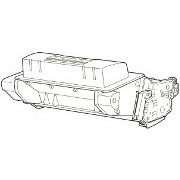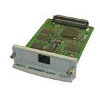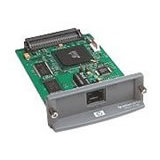HP Original Cartridges
JetDirect EIO Cards
JetDirect 620n are still available new from distributors in July 2015 but the price is a strong incentive to buy a "refurbished" card.
Reliable Remanufactured Cartridges
One of the merits of the P4014 against a new printer is the low cost of good re-manufactured cartridges.
At the moment we don't sell in the US, but we hope to soon
Error Message 40: HP P4014, P4015 & P4515 Printers.
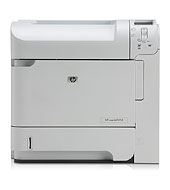
Error 40 looks like there is some communication problem hitting a network EIO card. Most modern communication protocols allow some level of error (older communcations like RS232 and parallel-ports didn't always do so). This may be a residual error from those days, or might be invoked when a network link descends to chaos.
40 EIO X BAD TRANSMISSION
Any communication link can fail. Most but not all communication programs attempt to detect and correct errors, so a TCP telnet link (for instance) can recover several minutes later (or hours) after being unplugged . Not all protocols are so tolerant. A printer really needs to either finish a task or move on so if print information ceases or contains uncorrectable garbage the printer will say so.
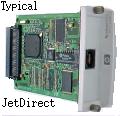
40 EIO X BAD TRANSMISSION "To Continue Press OK" . EIO cards are the slide-in communication modules in the back of printers. There can be as many as three EIO positions in big machines like the LaserJet 9500, allowing them a hard disk and two network cards. The LaserJet P4014 family only provide one EIO slot.
40 EMBEDDED I/O BAD TRANSMISSION "To Continue Press OK" . Embedded I/O is the network port built onto the printers formatter board, it counts as EIO 0.
The message might also be Press OK to clear the error message and continue printing.
- documentation seems to vary a bit. It seems a bit questionable whether you will actually be able to continue printing.
Ethernet and the TCP protocol used for printing both use checksums to ensure that packets received and used contain no errors. If the packet does contain an error it is discarded and sent again. It is possible for any electrical transmission to contain errors and glitches as plugs are pulled, lightning strikes or just someone plugging in the vacuum cleaner. Ethernet and TCP divide data into packets partly so that they can discard errors. Errors are not frequent on recent networks, but they happen.
Some protocols are highly tolerant to an error and will recover from a problem even if they can only do so hours later. Printers may be a bit different; we don't want the machine sitting idle because it is retrying something which happened a while ago. We probably want it to retry a few times and then give an explicit error.
Remedies
One-off occurrences are probably meaningless, somebody pulled a plug in a patch panel, turned off a router or a glitch hit a communications link.
One possible remedy is to turn off the printer's recognition of protocols that aren't wanted; probably Appletalk, DLC and IPX (they are there for backward compatibility and rarely used in recent networks. ) If the printer supports IPv6 but you don't use it turn it off as well. If you use IPv6 then turn off IPv4. The best that can be said for leaving support turned on for things not used is that it may do no harm; however it may also use up buffer space and cause errors to be reported that simply wouldn't have been seen if those packets had been rejected.
Persistent errors need looking at. Both computers and the printer actually hold statistics on network transmissions collisions, for instance this from the Linux machine I'm currently using:
eth0 Link encap:Ethernet HWaddr 00:19:66:10:20:30
inet addr:192.168.01.10 Bcast:192.168.01.255 Mask:255.255.255.0
inet6 addr: fe80::219:66ff:1020:30d9/64 Scope:Link
UP BROADCAST RUNNING MULTICAST MTU:1500 Metric:1
RX packets:175765 errors:0 dropped:0 overruns:0 frame:0
TX packets:158796 errors:0 dropped:0 overruns:0 carrier:0
collisions:0 txqueuelen:1000
RX bytes:42623080 (40.6 MB) TX bytes:36645812 (34.9 MB)
Interrupt:16 Base address:0xa000
and for a P4015 printer HP LaserJet P4015 NPIAXXFAA / 131.100.00.130 Network Statistics General Hardware Address: 78E7D1333435 HP Jetdirect: J8003E Firmware Version: V.36.41 Manufacturing ID: 5019501900**** Data Rate: 100 Mb/s Web Browser Refresh Rate: 60 Seconds Packets Received Total Packets Received: 1557499 Unicast Packets Received: 36441 Broadcast Packets Received: 1521058 Bad Packets Received: 78 Packets Transmitted Total Packets Transmitted: 69468 Unicast Packets Transmitted: 46963 Broadcast Packets Transmitted: 22505 Transmission Errors: 0 | and for an older printer (from my ancient HP LJ 4000): Laserjet-4000N / 192.168.01.05 HP LaserJet 4000 Series General Hardware Address: 0001E6102030 HP JetDirect: J6057A Firmware Version: R.25.57 Manufacturing ID: 22014335902201 Data Rate: 100Mbps Web Browser Refresh Rate: 60 Packets Received Total Packets Received: 721209 Unicast Packets Received: 177705 Broadcast Packets Received: 543504 Bad Packets Received: 0 Packets Transmitted Total Packets Transmitted: 167128 Unicast Packets Transmitted: 156300 Broadcast Packets Transmitted: 10831 Transmission Errors: 0 |
If there was a network noise issue I would expect to see the RX and TX error counts climb.
Another possibility is a bad EIO card. Replacements are available here.
Web Research
We tried querying Google with P4015 "40 EMBEDDED I/O BAD TRANSMISSION"
in quotes. It gave About 86 results
as follows:
- HP Control Panel Message Page. I don't think anyone could argue with HP comming top for their own list of error messages. They could be more informative but they try to balance what they say with what the average reader wants.
- PDF from HP of the user guide for the P4010 P4510 series, which obviously does contain the list of error codes so it's a good response to the query.
- titaniumprint nice web page neatly summing up each of the possible errors along the lines in the HP manuals.
- mindmachine our own page on the P4515 which we are currently improving.
- platen.com offering a PDF of the service manual, which is obviously valuable and something we'd like to be able to do (but it's HP copyright and we are a small player).
- desy.de proffering the troubleshooting part of the P3005 manual - which isn't a match to the query but the nature of this kind of search makes that inevitable.
- laserprinterhelp.net seem to be using the service manuals to seed a discussion forum. As yet it isn't working very well as this article had 436 views but no rating and no comment. It appeared in the wrong place in Google search as well - this article is for the next fault. Curiously, HP forums are often missing from the results.
- scribd.com scribd's rather odd and clumsy flash/iPaper presentation of the service manual. Better than nothing, of course.
- manualowl.com offering a download of something they haven't got, an apology and a link to the HP business support pages. One of the links brought up the movie player on the Linux box I use (it didn't work, whatever the payload was supposed to be). ManualOwl seem to be getting on the first page in google by cutting random bits out of HP service manuals and sticking them on the bottom of their pages. The company seems to be terabytemedia.com run by Michael Goldfarb and based in Scottsdale AZ.
- manualslib offering a dreadfully clunky way to read a user guide. Whois suggest it seems to be Wind and Fly Ltd based in Seychelles and with a gmail address.
Web research yielded what most people would consider reasonable results but it didn't altogether answer my puzzles about what precisely the communication errors mean. Should we look for a fault in the EIO subsystem, one in the EIO/formatter link or something like noise in the network?
I'm getting a bit fed up with laserprinterhelp.net, manualowl and manualslib doing nothing more than cutting up manuals and cluttering search results (beat em or join em?) . However this time they are the bottom rather than top of the list.
Apparently TechCrunch has called Scribd “the social network for reading” and it has also been called "YouTube for documents". They are dumping the Flash format and switching to HTML5.
Copyright G & J Huskinson & MindMachine Associates Ltd 2013, 2015. Some pictures derived from HP User and Service guides. These technical pages do not constitute an offer for sale; just our knowledge at the time of writing. See the catalogue. Sales pages on this Web site use cookies to store user information. We also use Google Analytics to track site usage patterns.

